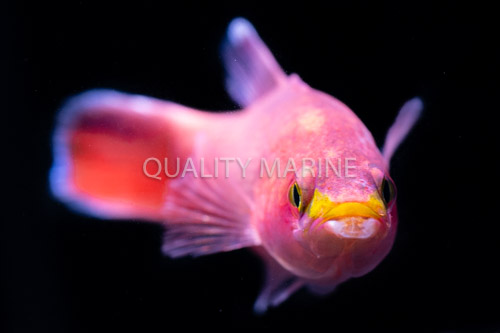The Pink Cave Basslet: A reclusive and lesser seen Liopropoma species

Many aquarium hobbyists seek out large and bold fish that are constantly active in their displays and will interact with their keeper to some degree, but theres a lot to be said about catering a system around more cryptic species. In fact, reef hobbyists are somewhat to thank for the inclusion of fish like this in the trade. As the demand rose for smaller fish that rather than larger fish remain pressed against the glass for the entirety of the day. Enter the basslets, these miniature groupers are much more reclusive than their larger cousins preferring to hide among the caves, coral and overhangs on the reef. They dont have a wide range in their natural habitats and prefer to stay within a few meters of their preferred hiding spots, this makes them perfect candidates for reef aquaria. Due to this and their diminutive size, its quite easy to replicate their needs in captivity, and with a little patience and trust, they make a great display. One of the lesser-seen Liopropoma sp. reef basslets seen in the trade is the Pink Cave Basslet (Liopropoma mowbrayi) also known as the Ridgeback Basslet.

Like the other Liopropoma basslets, the pink cave basslet has an elongated body and a pointed snout, but the Pink Cave Basslet also features a brilliantly pink body with yellowing in the snout and mouth area. They reside in deeper water compared to many of their co-genitors being found no shallower than 100 feet (~30 meters) with 165-200 feet (~50-60 meters) being common as well. The Pink Cave Basslet has a range from the Western Atlantic waters near Florida and the Bahamas to as far as northern South America. This limited range and deeper water-dwelling present fewer collection opportunities than their indo-pacific cousins. They are zooplanktivores that feed on small crustaceans usually in the water column and thus are completely safe around corals and other sessile cnidarians in the home reef aquarium. The one word of caution is that they will prey upon extremely small crustaceans, but they stay small enough that most ornamental shrimp you include in your reef should be safe.As mentioned above, they are secretive, but as they adapt to their new home and begin to associate a human presence with food they will become more active. In particular, look to observe them during the dusk phase of most modern reef aquarium lighting systems. To further encourage daytime activity, they should be housed with less boisterous and non-predatory larger fish such as larger groupers and lionfish. They are generally observed as singular specimens in the wild, excluding when they bond to mate and can become territorial to other individuals and con-specifics. If you plan to include multiple basslets in your aquarium, it will need to at least double or triple the size of a tank recommended for a singular specimen and contain many hiding spots to avoid aggression.

The Pink Cave Basslet adapt quickly to captivity, is resilient )and mostly disease resistant), has a wide compatibility range and allows the opportunity to set up a biotope for more reclusive deeper water fish. It is sure to add a flair of personality and color to your mixed reef aquarium.